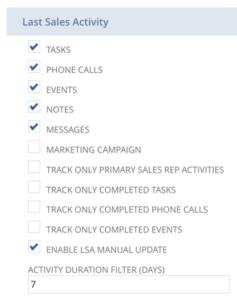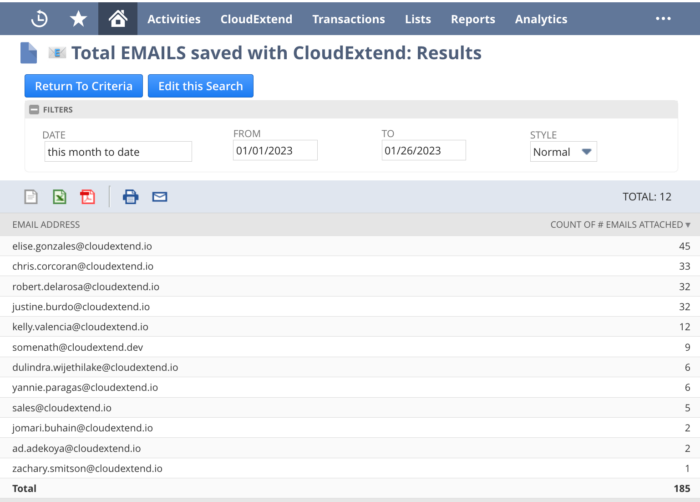Sales leaders track the obvious productivity metrics both at both a company and individual level. These metrics include quota attainment, average selling price (ASP), win rate, gross margin, etc. What other metrics should you be tracking and why? Here are five sales activities you’re not tracking, or, if you are, they’re probably not accurate.
1. Last Sales Activity (LSA)
During the sales cycle for new and even existing customers, one of the easiest global sales productivity metrics to track is the last date a sales activity occurred for an account. If you’re using a CRM like NetSuite or Salesforce, you can leverage native functionality to customize what triggers an update to LSA and then report on each activity by rep, marketing campaign, etc. Just as important as what triggers an activity is what doesn’t. You’ll want to make sure that emails from accounting, finance, etc., do not trigger an update to the LSA since these are not sales motions.

But here’s the rub: Your numbers are wrong because not everyone is using the CRM for emails, events, tasks, etc. Why? For many CRMs, it’s inefficient and requires copying and pasting between two systems. Salespeople need to be efficient with their time because for them time is truly money. For this reason, your top sales rep probably ranks lowest when measured on LSA if you’re not giving them a quick and easy path to recording their activities.
Make it Easy to Record Activities
The solution is to make it easy for your sales reps to record their activities in your CRM without missing a beat. Applications like ExtendSync enable sales teams to automatically add important emails, events, and more to the NetSuite CRM thus ensuring that the CRM has the most relevant up-to-date information available.
2. Emails
Many sales managers are familiar with call/video recording applications like Gong and use them for effective coaching. But what about emails? Sales managers want to know how many emails are being sent and the best managers will also actively review email content to ensure that the sales team is delivering the right message at the right time.
Using a CRM like NetSuite, managers can review email content as well as measure the number of emails generated by each salesperson. Once you’ve defined a good ratio for your business (whether it’s time-based, as a percentage of leads or opportunities, etc.), you need to ensure that the data is transparent and accessible to everyone, typically via a dashboard in your CRM. Caution should be taken if you are measuring sheer volume alone as it does not consider the effectiveness of the emails.
Salespeople who deliver on this metric demonstrate that they are committed to developing sustaining relationships with their customers and prospects, and sales managers who review productivity metrics and content will outperform their peers.
3. Meetings
When a salesperson has a meeting booked with a prospect it sends a signal that the interest in buying has moved up a notch (or more, depending on your business). Knowing how many meetings your salesperson has is important, but it does not provide the full picture.
Sales managers should stack rank meetings on the metrics that matter. Some to consider would be Meetings per # Closed Won Opportunities, Meetings per Total Number of Customers, Meetings per Week, and more. Similar to email tracking, caution should be taken if you are measuring sheer volume alone as it does not consider the effectiveness of the meetings.
Consider the salesperson that has 50 meetings in a week and converts two into sales vs. the salesperson that has 15 meetings in a week and converts five into sales. There are many ways to measure meetings. Find the right way to measure both meeting volume and meeting effectiveness and coach your underperformers to be more effective.
4. Time Saved Using Productivity Tools
So you’ve taken our advice and you’ve made it easy to record specific activities to your CRM. The obvious benefit is 360-degree visibility for everyone with access to the CRM and a fair method of benchmarking activities. In order to accomplish this you’ve invested in an application like ExtendSync or built your own integration. Now it’s time to measure the ROI to prove that the investment in the solution is worth it.
There are non-tangible factors that are harder to measure such as the full impact of the 360-degree view. Some of this will be anecdotal, such as a member of the finance team seeing a customer email promising to pay thereby saving time chasing down the rep and making an embarrassing call to a customer. Others, however, are tangible. If it takes one minute to save an email manually vs. 15 seconds with your new application, then you create a metric that adds up the total time saved and even converts that to dollars.
When your CFO asks about your budget, you now have firm numbers to back up your assumptions.
5. Summarize It All with A Dashboard
While not a single measure per se, providing a dashboard that is accessible to salespeople and sales leaders will make sure everyone is looking at the same set of metrics. By embedding your dashboard inside your CRM, you’re also giving your salespeople an added incentive to login to the CRM. Consider adding other incentives as well such as an individual dashboard for each salesperson that has all their commission calculations. You’ll be surprised how quickly CRM adoption will progress.
Sales leaders should be able to see total metrics for each activity type in the organization and be able to drill down to individual teams or sales reps. Once users start to see the benefit of having this information at their fingertips in their CRM, they will begin to use it more.
Knowing who is adding emails, events, tasks, etc. to your CRM and how often (as well as who isn’t) can help your leaders enforce these mandates. Many CRMs such as NetSuite allow you to build dashboards that show activity at a global and rep level.


The Path to Making NetSuite the Single Source of Truth
Virtually every business wants its CRM to be the most trusted source of information. It is often difficult to accomplish because it is not always easy to add information, such as emails, files, and events. Business users have many priorities and if getting information into the CRM is very manual, they often will not do it.
Business users live in their email inboxes. Finding a solution like the ExtendSync email app that integrates with NetSuite right from where they already work every day can bring the best of both worlds to an organization. Try it free today.
